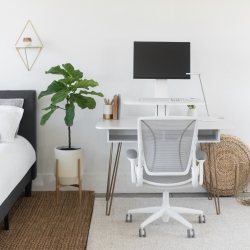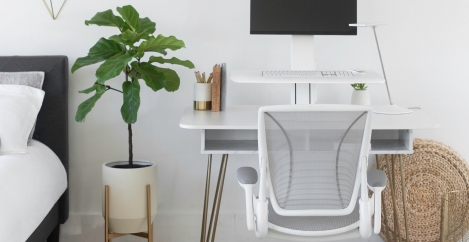April 1, 2020
The lights are on and there is definitely someone home
 As COVID -19 has taken hold and the very necessary lockdown begins, there are A large number of workers thrown into semi-permanent work settings that we hadn’t anticipated a month ago. The transitions will be easier for some than others but we all need a space that feels comfortable AND is conducive to productive working.
As COVID -19 has taken hold and the very necessary lockdown begins, there are A large number of workers thrown into semi-permanent work settings that we hadn’t anticipated a month ago. The transitions will be easier for some than others but we all need a space that feels comfortable AND is conducive to productive working.
We may think about where we are going to sit and the position of our laptop but often given less thought is light, this may be partly due to the fact that in an office space, the control of light levels sit with FM team or even the SMART building technology but in your own home you can relinquish control.
Light impacts our whole sense of wellbeing and purpose, not only does it keep US aware and alert, it can invigorate and inspire, helping productivity and importantly it can reduce eye strain. The correct lux levels are different for everyone, so working at home is an amazing opportunity to set it for your exacting requirements.
Light in layers
‘Lighting in layers’ is a way to break down the different elements of light available and view the output with a degree of flexibility that the user can alter through the course of the day or to suit a particular activity being undertaken, things to consider:
- How the light is distributed
- Identifying areas that maybe under lit in the room and correct this by adding a table lamp.
- The lighting levels in the spaces where you will be working such as desks and reading chairs.
Once these have been considered you can start to build a better lighting design from there.
To layer your home ‘office’ lighting you will need to take into account different sources namely ambient, task and accent, all working in harmony with natural light:
Ambient lighting
The goal is to illuminate the space without creating glare and contrast while at the same time avoiding casting harsh shadows.
This is the general lighting, or the light you use on a day to day basis within the room and move around safely, this is generally provided by ceiling and wall luminaires. This is the starting point for your office.
Take a look and see if the lighting provides an even level of illumination, this makes it possible to introduce other types of lighting without creating dramatic shadows and other problems that could lead to eye strain and fatigue.
Always avoid working under the direct glare of the overhead lights and look for ways to diffuse the ambient light that will illuminate your office. Lampshades can soften and scatter otherwise harsh light, while an upward shining floor lamp can bounce the light of the ceilings and walls providing a good comfortable diffused level of light.
Task lighting
This type of lighting is required in any areas where you will be performing tasks like reading, writing, or computer work, a good quality task lamp (use Humanscale as the benchmark) will provide even light across the work surface.
Task lighting provides a focused light that illuminates the detail of the work you are doing without straining your eyes and causing long term damage.
Choose a well-defined light source dedicated to what you are doing, adjustable lamps can be directed exactly where you need it and support a variety of tasks.
Decorative lighting
The final layer of lighting helps to accentuate architectural items and details within the room that you want to highlight, such as artwork, recesses etc. this provides highlights within the space helping to create a more visually pleasing environment.
If you don’t have a lot of natural light, then artificial lights are even more important when looking at home office illumination.
Key considerations:
- Where your light emanates from? A light source set behind you will create glare on your screen while you work and in time will be very irritating.
- Where are the windows located? If you are not positioned correctly these can be a source of considerable glare.
Natural light
The benefits of natural light are well documented, whether that is from a window or skylight. Daylight can create excellent lighting to a space that can improve the working environment, however consideration must be given to the control of how it floods a space.
Ideally a room should be controlled by the use of blinds, solar shades and curtains, so as the sun moves across the sky and changing the dynamics of the room and the amount of light can be blocked if necessary.
It is best to have natural light in front or next to work desks and computer screens, in order to avoid glare and provide a worker with an outside view, all of which will reduce any eye strain during the course of your working day.
If possible position your workstation facing north or south so sunlight doesn’t throw any shadows during the course of the day.

Chris is Design Principal at FUTURE Designs www.futuredesigns.co.uk














